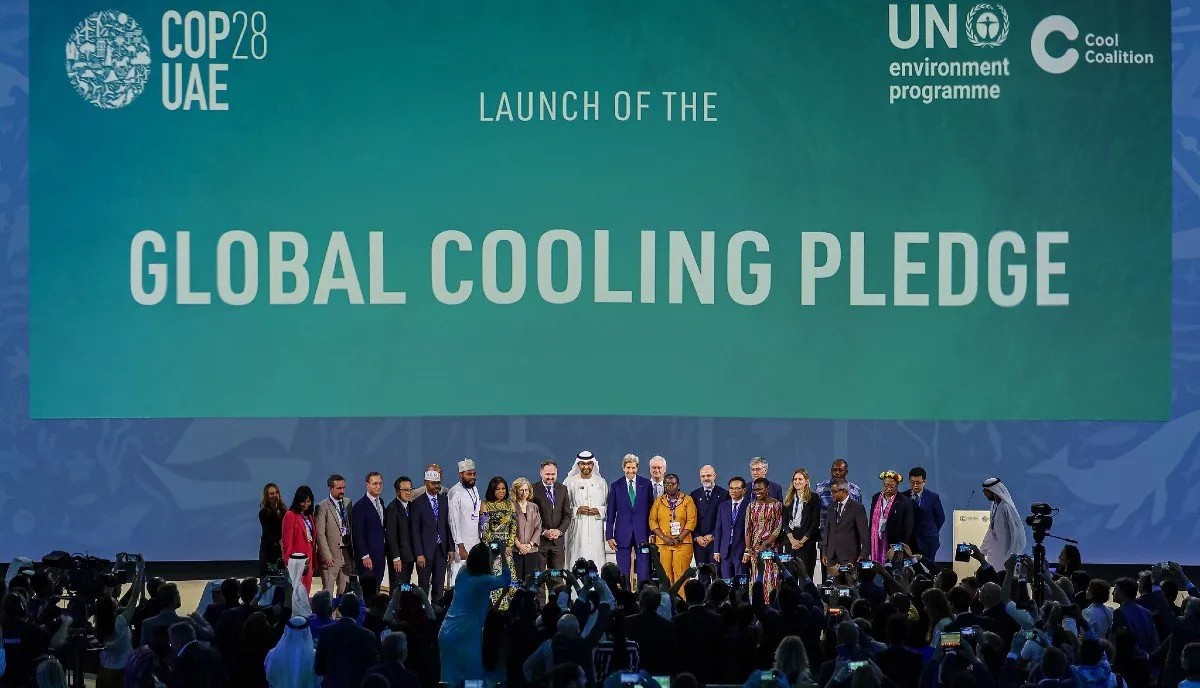Faster HFC phase down would help cut 2050 cooling emissions by 60%
December 11, 2023

A faster phase down of HFCs via the Kigali Amendment to the Montreal Protocol was cited as one of the measures that would cut at least 60% off predicted 2050 emissions from the global cooling sector, according to a new “Global Cooling Watch” report published during the COP28 climate talks in Dubai.
The report, called “Keeping it Chill: How to meet cooling demands while cutting emissions” – which was prepared by the UN Environment Programme-led Cool Coalition– lays out sustainable cooling measures in three areas: passive cooling, higher energy-efficiency standards and a faster phase down of climate-warming refrigerants. “Following the measures outlined in these areas would deliver the 60% cuts; adding rapid power grid decarbonization would reduce sectoral emissions by 96%,” according to a COP28 announcement.
As of 2022, while more than 80% of countries had at least one regulatory instrument in place in these areas, implementation remains inadequate, and an integrated approach is missing, the report says. Only 30% of countries have regulations that enable action on all the three fronts.
Faster action to phase down HFCs is possible and can achieve a halving of HFC emissions in 2050 – compared to the Kigali phase-down timetable – through rapid uptake of better technologies in new equipment, better refrigerant management and stronger national enforcement, says the report.
The Global Cooling Watch report was released in support of the Global Cooling Pledge, a joint initiative between the United Arab Emirates as host of COP28 and the Cool Coalition. Over 60 countries have so far signed the Pledge with commitments to reduce the climate impact of the cooling sector. ATMOsphere, publisher of R744.com, participated in the discussion surrounding the Global Cooling Pledge.
“Countries and the cooling sector must act now to ensure low-carbon cooling growth,” said Inger Andersen, Executive Director of UNEP. “Fortunately, the solutions are available today. Getting energy-efficient, sustainable cooling right offers an opportunity to cut global warming, improve the lives of hundreds of millions of people and realize huge financial savings.”
Cooling equipment represents 20% of total electricity consumption today – and this is expected to more than double by 2050, says the report. Greenhouse gas emissions from power consumption will increase, alongside leakage of refrigerant gases, most of which have a much higher GWP than CO2. Under a business-as-usual scenario, emissions from cooling are predicted to account for more than 10% of global emissions in 2050.
Benefits for climate, human health and prosperity
Following the report’s recommendations could reduce the projected 2050 emissions from business-as-usual cooling by around 3.8 billion tons of CO2e.
This would:
- Allow an additional 3.5 billion people to benefit from refrigerators, air conditioners or passive cooling by 2050.
- Reduce electricity bills for end users by US$1 trillion (€0.93 trillion) in 2050 and by US$17 trillion (€15.8 trillion) cumulatively between 2022 and 2050.
- Reduce peak power requirements by between 1.5 and 2 terawatts – almost double the EU’s total generation capacity today.
- Avoid power generation investments in the order of US$4 to US$5 trillion (€3.7 to €4.6 trillion).
Higher efficiency standards
Higher efficiency standards and better labeling of all cooling equipment would triple the global average efficiency of cooling equipment in 2050 from today’s levels, delivering 30% of modeled energy savings, lowering energy bills and improving the resilience and financial viability of cold chains, the report says.
Critical implementing policies include regularly updated Minimum Energy Performance Standards (MEPS), financial instruments to encourage demand for higher efficiency products and regulations to avoid the dumping of low-efficiency cooling equipment into developing countries.
Passive cooling measures – such as insulation, natural shading, ventilation and reflective surfaces – can dramatically reduce cooling loads, the report says. These can be provided, in part, by the development and enforcement of building energy codes that incorporate passive cooling, and urban design.
Such strategies can curb the growth in demand for cooling capacity in 2050 by 24%, result in capital cost savings in avoided new cooling equipment of up to US$3 trillion, and reduce emissions by 1.3 billion tons of CO2e.
The total life-cycle cost savings of $22 trillion/€20.4 trillion ($17 trillion in power costs savings and $5 trillion in power generation investments) will make the sustainable cooling transition affordable, the report says. Financial tools include on-bill financing (when a utility pays for an upgrade and recovers the cost through monthly power bills), risk-sharing facilities, public and private investments, green mortgages and seed financing for cold chains. For many developing countries, dedicated concessional finance will be needed as well as incorporating sustainable cooling criteria into banks’ lending practices.


